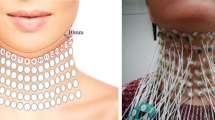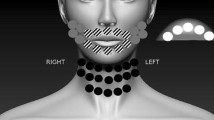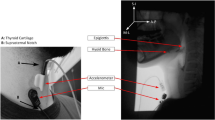Abstract
Surface electromyography (sEMG) is being used with increasing frequency to identify the occurrence of swallowing, to describe swallow physiology, and to treat impaired swallowing function in dysphagic patients. Despite this increased utilization, limited information is available regarding the validity and reliability of investigators and clinicians to interpret sEMG data in reference to swallowing. This study examines the validity and interjudge reliability of swallow identification using sEMG records obtained from healthy adults. Validity and reliability estimates were compared between experienced and naïve judges in the identification of swallows from graphic sEMG records. Multiple validity estimates were high, indicating a strong degree of accuracy in identification of swallows versus nonswallow movements from sEMG traces. Experienced judges were more accurate than naïve judges (classification accuracy: experienced = 90% vs. naïve = 81%; p = 0.006, kappa: experienced = 0.89 vs. naïve 0.62; p = 0.008). Judges in both groups were more likely to classify swallows as nonswallow movements (false negatives) than to classify nonswallow movements as swallows (false positives). Interjudge reliability estimates indicated a high degree of agreement among judges in the identification of swallows versus nonswallow movements from the sEMG signal, with higher agreement among experienced judges (average kappa coefficient: experienced = 0.75 vs. naïve = 0.51). These results suggest that the sEMG graphic record is a valid and reliable tool for identifying normal swallows and that experience with this technique results in better identification and interjudge agreement.

Similar content being viewed by others
References
Bryant M: Biofeedback in the treatment of a selected dysphagic patient. Dysphagia 6:140–144, 1991
Crary MA: A direct intervention program for chronic neurogenic dysphagia secondary to brainstem stroke. Dysphagia 10:6–18, 1995
Crary MA, Carnaby (Mann) GD, Groher ME, Helseth E: Functional benefits of dysphagia therapy using adjunctive sEMG biofeedback. Dysphagia 19:160–164, 2004
Haynes SN: Electromyographic biofeedback treatment of a woman with chronic dysphagia. Biofeedback Self Regul 1:121–126, 1976
Huckabee ML, Cannito MP: A direct intervention program for chronic neurogenic dysphagia secondary to brainstem stroke. Dysphagia 10:6–18, 1995
McKeown MJ, Torpey DC, Ghem WC: Non-invasive monitoring of functional distinct muscle activations during swallowing. Clin Neurophysiol 113:354–366, 2002
Vaiman M, Segal S, Eviatar E: Surface electromyographic studies of swallowing in normal children, age 4–12 years. Int J Pediatr Otorhinolaryngol 68:65–73, 2004
Falla D, Alba P, Rainoldi A, Merletti R, Jull G: Repeatability of surface EMG variables in the sternocleidomastoid and anterior scalene muscles. Eur J Appl Physiol 87:542–549, 2002
Gabriel DA: Reliability of sEMG spike parameters during concentric contractions. Electromyogr Clin Neurophysiol 40:423–430, 2000
Glazer HI, Romanzi LJ, Polaneczky M: Pelvic floor muscle surface electromyography. Reliability and clinical predictive validity. J Reprod Med 44:779–782, 1999
Neblett R, Mayer TG, Gatchel RJ, Keeley J, Proctor T, Anagnostis C: Quantifying the lumbar flexion–relaxation phenomenon: theory, normative, and clinical applications. Spine 28:1435–1446, 2003
Romanzi LJ, Polaneczky M, Glazer HI: Simple test of pelvic muscle contraction during pelvic examination: correlation to surface electromyography. Neurourol Urodyn 18:603–612, 1999
Crary MA, Baldwin BO: Surface electromyographic characteristics of swallowing in dysphagia secondary to brainstem stroke. Dysphagia 12:180–187, 1997
Ding R, Larson CR, Logemann JA, Rademaker AW: Surface electromyographic and electroglottographic studies in normal subjects under two conditions: normal and during the Mendelsohn maneuver. Dysphagia 17:1–12, 2002
Haas M: Statistical methodology for reliability studies. J Manipulative Physiol Ther 14:119–132, 1991
Mossman D: Assessing predictions of violence: being accurate about accuracy. J Consult Clin Psychol 62:783–792, 1994
Fleiss JL, Cuzick J: The reliability of dichotomous judgements: unequal numbers of judgments per subject. Appl Psychol Measure 3:537–542, 1979
Landis JR, Koch GG: The measurement of observer agreement for categorical data. Biometrics 33:159–174, 1977
Author information
Authors and Affiliations
Corresponding author
Rights and permissions
About this article
Cite this article
Crary, M.A., Carnaby (Mann), G.D. & Groher, M.E. Identification of Swallowing Events from sEMG Signals Obtained from Healthy Adults. Dysphagia 22, 94–99 (2007). https://doi.org/10.1007/s00455-006-9059-y
Received:
Accepted:
Published:
Issue Date:
DOI: https://doi.org/10.1007/s00455-006-9059-y




